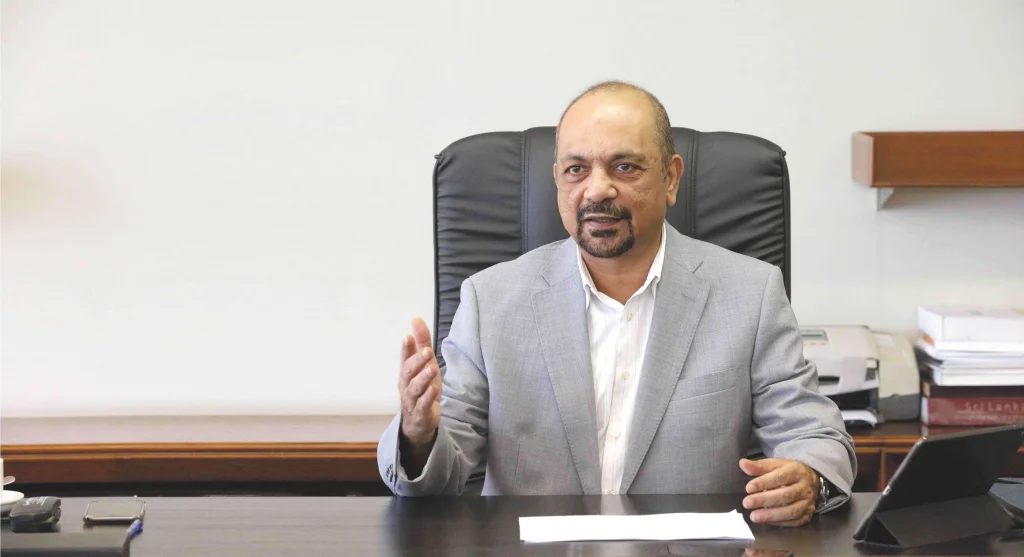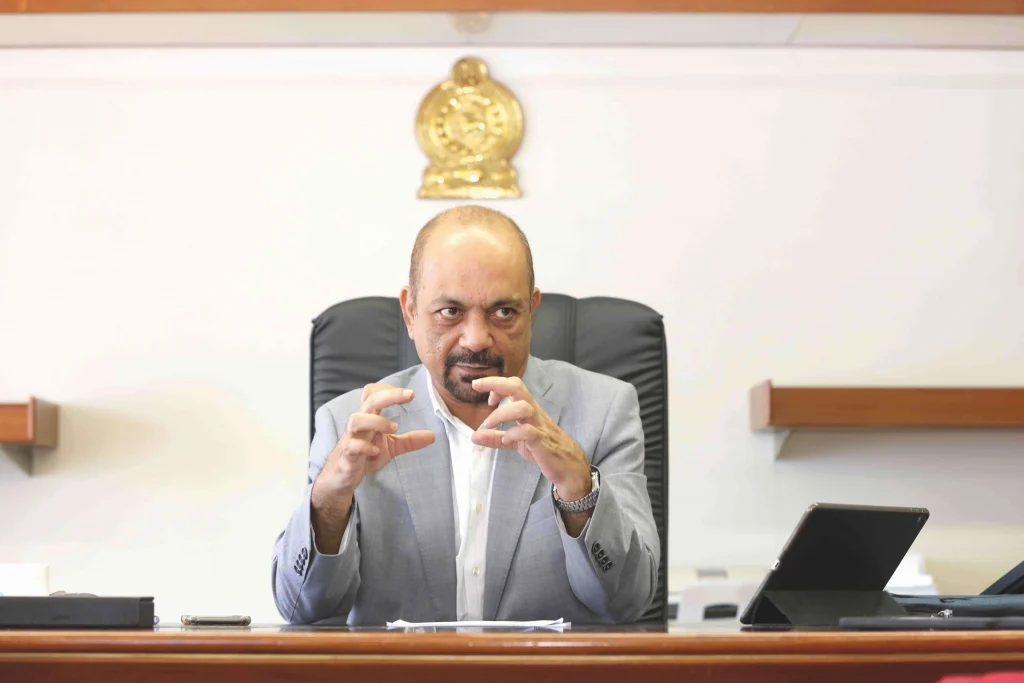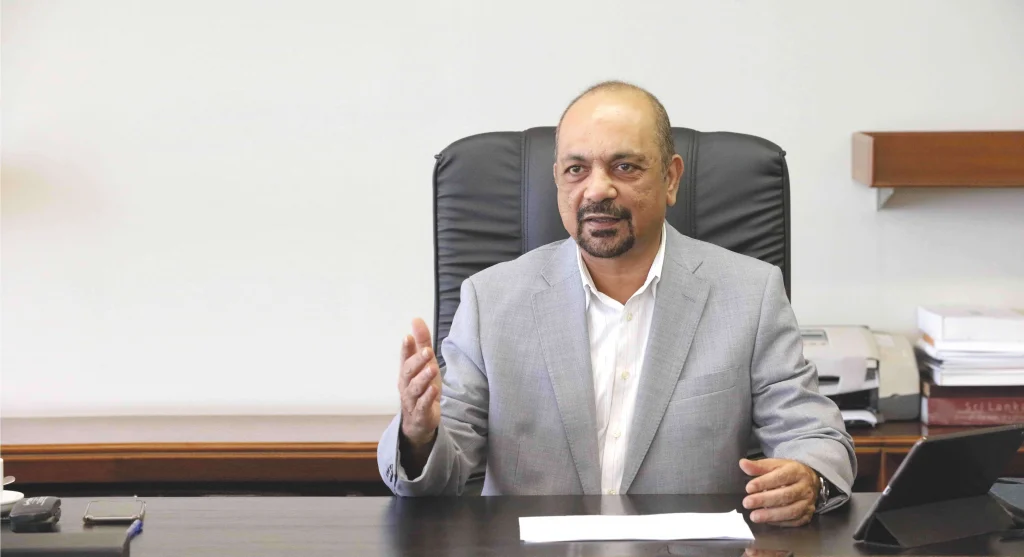
The Bank of Ceylon is fighting the good fight and running the race against the country’s economic challenges. Remaining true to its tagline ‘Bankers to the Nation’, the Bank of Ceylon is proving again that it is resilient as the largest bank in the country by posting outstanding results in a COVID-19 riddled 2021. It has recorded the highest ever PBT in any financial year.
Kanchana Ratwatte, Chairman, speaking to Business Today, disclosed the Bank’s performance since 2021 and its commitment to buttress government efforts to rein in the challenges of the economic crisis Sri Lanka is facing right now. The Bank has steadfastly supported the sustenance of important sectors in the country through the difficulties of the COVID-19 pandemic and the economic crisis, including SMEs and SME exporters so that they can continue contributing to the economy and aiding in the recovery process. While not downplaying the gravity of the situation locally, Ratwatte opined on the need to consider the bigger global picture of events butting into an already embattled economy. However, he is confident of an economic revival. He is optimistic about BoC’s vital contribution as it remains as it has in its history, overwhelmingly deep- rooted in the country’s economic development trajectory.
Words: Jennifer Paldano Goonewardane.
Photography: Sujith Heenitigala and Dinesh Fernando.
The momentum before the present was the COVID-19 pandemic. The banking sector most remarkably weathered the storm by adhering to government calls for moratoria and special loan programs and enjoyed flexibility measures by regulators and supervisors. Can you tell us about BoC’s experience and how the Bank has performed in 2021 and the first quarter of 2022?
Thank you for giving me this opportunity to showcase the story of the Bank of Ceylon in the aftermath of the 43.2 billion rupees Profit Before Tax that we made in 2021, which was the highest BoC has made in any financial year. I must confess that 2021 was a year in which the Bank, the country, and everyone had one of the most trying periods due to the COVID-19 pandemic continuing beyond the expectations of the global community. Despite the pandemic, supported by the intervention of the Central Bank and the reduction of interest rates, all financial institutions in the country have made significant profits during the year under review. Note that whatever the substantial gains the Bank of Ceylon made were not made at the cost to the customers.
The growth in our loan and investment book by one- third was the key contributor to this remarkable PBT in 2021. Remarkably, our lending to the private sector grew by nine percent that year as we focused intensely on maintaining the quality of the loan portfolio and assisting non-performing facilities to be strengthened.
BoC earned 3.6 billion US dollars as remittances for the 2021 financial year, which was the highest the Bank achieved during a financial year. As a state bank, whatever profits or gains the Bank of Ceylon makes are plowed back into society either by way of dividends, taxes, or with the growth of the asset, whichever way it remains in the hands of the general public. Those do not belong to any individual.
In the first quarter of 2022, the Bank of Ceylon achieved an asset base of four trillion rupees, a ten percent growth, and I would say a remarkable achievement amid many challenges. Since 2018 it has taken a few years for BoC to achieve a trillion in its asset base, surpassing three trillion rupees in 2021, and within a matter of months, we have increased it to four trillion rupees in the first quarter of 2022.
BoC earned 3.6 billion US dollars as remittances for the 2021 financial year, which was the highest the Bank achieved during a financial year.
As a state bank, whatever profits or gains the Bank of Ceylon makes are plowed back into society either by way of dividends, taxes, or with the growth of the asset, whichever way it remains in the hands of the general public. Those do not belong to any individual. The Bank’s shares are owned a hundred percent by the state. Therefore, profits are plowed back into society, apart from the direct CSR activities, which are insignificant in the bigger context.
As the Bank recorded one of the best PBT in its history, a Fitch Ratings downgraded BoC’s ability to service obligations in foreign and local currency in the event of a sovereign default.
It is important to point out that the Bank’s significant PBT was reported just before the Fitch Rating announcement. Both events happened in the same week. I want to stress that the Bank of Ceylon is the only domestic systemically important Bank with an international rating. None of the other banks have a global rating. The local rating remains as it was. However, being a state bank, our rating is dependent on the sovereign rating. Any sovereign downgrading gets reflected within a very short period on the Bank’s rating.
Historically, whenever the Fitch Global Rating issued a rating for Sri Lanka, within weeks or months, that same rating became applicable to the Bank of Ceylon. For instance, in July 2011, the country rating of BB- was applied to the Bank of Ceylon in April 2012. Likewise, the Bank reflected a B+ country rating in February 2016 by March 2016. This list continues in some of the following years until the most recent sovereign downgrading to Restricted Default in May 2022. Subsequently, the Bank, due to the country’s weakened credit profile affected by its strained foreign-currency funding and liquidity profile, received the same foreign currency rating in June 2022.
The rating downgrading occurred within a week of BoC announcing its stupendous PBT of 43 billion rupees in the media. That is indicative that it is in no way a testament to the Bank’s performance or capability. As a state bank, it concurrently reflects the ebb and flow of the country’s response to its external obligations. Therefore, the downgraded rating was a reflection of the country’s rating, and the Bank, in isolation, hasn’t had any impact by the extraneous factors that do not affect its performance.
As BoC calls itself the ‘Bankers to the Nation,’ it has contributed to the country’s socio-economic stability over the years. What has been BoC’s commitment to the macroeconomy in the recent past?
Over the last ten years, Sri Lanka has been importing 22-23 billion US dollars’ worth of goods annually. Our annual export volume has been around 10-13 billion US dollars. Annual remittances that account for nearly five to seven billion US dollars bridged the 10 billion US dollars deficit somewhat. Tourism used to annually provide between 2.5-3.5 billion US dollars, the highest being 4.38 billion US dollars in 2018. So, there hasn’t been a significant gap between earnings and expenditure. The country could survive on this, and we had a reasonably decent standard of living in Sri Lanka. Then in 2021, our remittances declined significantly from around seven billion US dollars in 2020 to five billion US dollars. The decline in tourism due to COVID-19 and other factors meant we had only 500 million US dollars as income in 2021.
Apart from this, the BoC was directly involved in the COVID-19 vaccination program by financing 138 million US dollars for vaccine importation in 2021, which was a significant amount. However, we are extremely proud that significant amount helped the country achieve a relatively high vaccination rate.
The government continued to maintain petroleum prices at restricted levels to ensure that there was no severe impact on inflation. The pegging of the dollar ensured that there would not be inflation amid the pandemic. But no sooner than lifting these restrictions, Sri Lanka faced hyperinflation’s repercussions.
Apart from the earnings from remittances, we had to ensure that the livelihoods and economic activity moved on uninterrupted. Despite the challenging foreign currency position, the two state banks took on the onerous task of importing fuel, cooking gas, and pharmaceuticals into the country. As we speak today, we know that a fuel shortage will bring the country’s activities to a grinding halt. The BoC took a risk at the time by opening Letters of Credit to ensure the continuation of livelihoods, and we had to take that responsibility despite the economic downturn. Despite what was happening in the country then, we secured the maintenance of livelihoods by ensuring that fuel supplies continued to fulfill the country’s requirements. That, of course, had a severe impact on our other businesses.
As you know, during the year, petroleum prices increased due to various external factors, and the demand for it also increased due to power outages. When there’s a lack of electricity supply and no continuous power, the demand for generators increases, so all these factors put together, it was
an unprecedented situation that has enhanced the requirement for fuel in the country. Previously the daily release of fuel was between three to four metric tons. As of now, that quantity has gone up to seven metric tons a day. And still, the country is experiencing scarcity. A year ago, the monthly requirement was in the range of 350 million US dollars. Today even at 650 million US dollars, we cannot maintain adequate stocks. So, this is the magnitude of the problem we face as we go. However, we continue to operate, demonstrating our commitment to the country. We will make the best effort to keep the economy moving because only if we keep it moving will the other financial institutions and the rest of the country survive. Suppose fuel stocks and supplies come to a grinding halt. In that case, we will have no way out of this situation because without transportation, the individual who uses public transport to commute to work and back and for other purposes will be helpless. Basically, under such an extreme scenario, nothing can be sustained. Hence, we have to ensure that the transport sector functions and the households have access to cooking gas back on track if Sri Lanka is to maintain itself until the successful completion of negotiated external assistance.
What can you tell us about the state of non-performing loans of your Bank, given that it was very much concerning during COVID-19? Is it the same as the pandemic levels, improved or worsened?
I want to draw your attention to a significant thing that the Bank achieved during the height of the COVID-19 pandemic. The Bank noticed that year on year, non-performing loans were growing and getting bigger. In that scenario, we initiated the Business Revival Unit, a dedicated outfit established to revive affected corporates and SMEs by providing new facilities and enhancing internal capabilities. These companies had fallen into distress due to various factors traceable to pre-COVID-19. They could be due to policy decisions, mismanagement, or diverting money for purposes outside initial plans. Whatever the reasons, we took these distressed companies under the wing of a Deputy General Manager, and we have managed so far to secure thousands of employees’ livelihoods and the revival of these companies. As of the end of 2021, during the second year of establishing this Unit, it has rehabilitated over 16 customers, thereby securing the livelihoods of over 4,900 individuals employed in these enterprises. The total amount so revived is over 30 billion Sri Lankan rupees.
Today it’s called the Business Rehabilitation and Revival Unit. The BRRU is a dedicated unit set up at the head office. We have extended this program and opened up regional revival units, which are already functional in all the regions. Every unit has a dedicated staff that initially looks at the highest 25 businesses of any region that has for some reason not been successful and lagged in the non-performing category. The significance of this program is that while the Bank is best at banking, the individual who has gained knowledge in some business but has been unable to service the Bank should not go unutilized. The principle behind this is that entrepreneurship is not something inculcated. Entrepreneurship is a trait intrinsic in an individual, and not every individual possesses entrepreneurial skills, so whoever has that skill but has been unsuccessful in the process, we took control of them and managed those businesses for them during that phase. With this, we have been able, in the second year of its launching by 2021, to revive 16 companies. The three billion rupees impairment provision in 2020, was reversed in the 2021 financial year, adding to the profits.
In addition, the Bank of Ceylon continues to be at the forefront of extending moratoria for affected businesses and individuals, with over 97,000 facilities receiving moratoria of around 380 billion rupees in 2021.
As a state bank, BoC will continue its strategic focus on fuelling the growth of this sector because we know that it will remain the engine of growth, supporting Sri Lanka’s economic recovery in the future.
From a layman’s perspective, what’s the relationship between bank-specific moratoria and NPLs?
There are various proposals inside this single scheme. From now on, we give a period during which the customer pays only the interest. The other option is
to offer another period in which the Bank will create a new loan to assist the customer to continue and extend the loan period to ensure that the customer navigates through this period. While those are the two primary schemes, we intend to approach the situation on a case-by-case basis to help a distressed customer. For instance, if a customer had borrowed at 12 percent, but today if that instalment payment is beyond the reach of a customer, those are the individuals we hope to assist. We believe the second quarter of the current financial year will be challenging. However, we may be able to see a revival of business in the third quarter enabling our regular customers to return to normalcy.
We are yet to feel the impact of this crisis because we know the exacerbation of the current situation took place only in the past two months. We have introduced our moratorium package as the Central Bank announced that there would be no further extension of the former moratoria. Following the pandemic-led stress on businesses, today, in this current situation, the SMEs and large-scale businesses are urging for a moratorium to overcome the immediate problems faced. The Central Bank has been extending the moratoria for the tourism industry from 2019 and other sectors from 2020 through 2021. It has now provided the banks the discretion to carve out their exclusive packages. We intend to introduce our relief package until 31 December 2022, subject to Central Bank approval. We will ensure that our customers are taken care of no sooner than receiving the Central Bank’s green light during this most challenging period. I suppose this is the most difficult phase we are going through. Once we sort out the issues regarding transport and logistics, we should be able to get our industries back on track.
How have the Bank-supported groups in the export ecosystem been encumbered by the vulnerabilities beginning with COVID-19?
We know the importance of addressing Sri Lanka’s external sector vulnerabilities through sustainable long-term solutions. In supporting this agenda, the BoC has recently focused on strengthening Sri Lanka’s SME exporters. The launching of the BoC Export Circle was another significant program in 2021 dedicated to providing exporters a platform for networking opportunities and capacity-building, and financial support. That too was initiated at the head office with a dedicated staff who offer end-to-end services. A significant number have already utilized this service.
In 2021, this initiative supported 80 new SME- level exporters and 351 exporters through awareness programs conducted across the country. The Board of Directors and the Corporate Management team were actively involved in this endeavor. They had the opportunity to engage directly with SME customers across the country, understand their concerns, and assist them by offering practical solutions. As a state bank, BoC will continue its strategic focus on fuelling the growth of this sector because we know that it will remain the engine of growth, supporting Sri Lanka’s economic recovery in the future.
In the current crisis, exporters have been affected by an inability to keep to schedules. It impacts their production lines, capacity to service on time, and export on schedule, and we will have to consider them separately. If not, as far as banking activities are concerned, exporters are the most cushioned set of people because they earn in US dollars or foreign currency.
It’s the import trade that is impacted significantly in this phase. We had a situation where importing goods was happening under the Open Account Payment Terms. Today restricting that to ten varieties by the Central Bank, the balance goods have to come through standard Letters of Credit Documents Against Payment or Documents Against Acceptance terms in the banking system. As we move forward, we should see a significant improvement in forwarding monies through the banking system.
As there is an intense drive to encourage foreign remittances, BoC has been a leading bank facilitating foreign remittances. As the economy dives, how has BoC navigated through that ecosystem, and how has the response been?
We account for nearly 40 percent of the remittances coming into the country. We have our network in the various touchpoints in South Korea, the Middle East, and Europe with our agents. Those agents assist our workforce in facilitating the process on an individual basis so that even if someone were to hit a snag trying to remit money home, they could reach out to our agents for assistance. With the number of individuals, we have placed outside the country, it has always been a personalized service we at BoC have extended to our migrant workforce. However, due to the overall situation, we have seen a loss of remittances in the first few months of 2022. However, with the relaxing of exchange rate controls and higher remittance returns, we see a significant improvement in that status. I believe that we will recover our normal levels of remittances in the future.
Future-ready organizations don’t let uncertain times stifle technological advancement, product innovation, or customer focus. Digital disruption was happening at a fast pace even before the pandemic. But the pandemic provided the impetus for its expansion. How challenging was that, and how has it benefitted your Bank and your customers’ response?
We have high-end technology concerning customer services, introducing systems to place ourselves above the situation. Our transformative journey into digitizing the customer’s journey began before the pandemic. Our investments in this area have been more than 4.5 billion rupees. That became all the more significant during the COVID-19 pandemic because of restrictions to people’s movement and while our branches were kept open only for limited services. But most customers, regardless of age, were able to do the transition to digital banking in 2021. With the digital expansion and the increasing number of customers transitioning into this new way of banking, we did encounter a few technical issues.
However, overall, we have navigated ourselves and emerged in control of the situation. We are today a fully digitized bank with a comprehensive array of digital solutions for many services. At the heart of this transformation is recognizing our customers’ diverse needs. Today, the network is perfectly customer-ready. It’s a case of customers getting themselves more accustomed to digitized services. The customers’ response is highly admirable as our investment in digitizing pays off, especially in 2021 with a reported increase of 43 percent in the Bank’s digital transactions while the value of those transactions had increased by 58 percent. By the end of 2021, digital transactions had accounted for 38 percent of the Bank’s total transactions.
In the future, what will be the likely changes impacting the banking industry? Do you see any unique marketplace opportunities that you can take advantage of?
Considering the globally restrictive environment, substituting imports was a significant step that enabled innovation. Despite the limitations, it’s remarkable how the agriculture sector has spurred an improvement in the local production in certain areas. Innovation concerning import substitution, such as circumventing the shortage in cooking gas, the Bank has assisted entrepreneurs who have come out with innovations to overcome that issue. These entrepreneurs would not have survived if this import had been freely available. The question in the long-term is whether they can sustain themselves following the restoration of cooking gas supplies in the market. Or better still, if they could improve their product so that they stay competitive even after cooking gas supplies to the market are restored. Indeed, the current market conditions have helped such vendors. Even during the pandemic-driven lockdowns, some vendors went from house to house, triggering a new business model. That created a new value chain of delivering goods to the doorstep. As a result, many IT companies leveraged this new demand for deliveries at their height. It was not just for food but a range of commodities. People have come to trust even the garment they purchase online without the former experience of touch and feel that was so essential to customers. These innovations drove new businesses to help people navigate a new normal of living in a restricted situation, which is applicable even today.
With the current situation, we are undergoing, if you consider the person-hours we’re losing, even to draw people to the factories, for a patient to go to a hospital, be it services or manufacturing, we will inevitably see a downturn in economic activity. For the first quarter of 2022, BoC has maintained a profit of eight billion rupees. However, in the second quarter, we would see the impact on the entire economy due to these factors, for which we have introduced until 31 December a credit package, which is a bank-specific moratorium, pending Central Bank approval, which would phase out the problem.
I think the country has no future if we don’t believe in ourselves as a country and that we are going to bounce back to normalcy in the foreseeable future. We need to believe in ourselves. As we speak, several bilateral and multilateral discussions are taking place, leading in the same direction of resolving the current issues as we go along. Most of them may end up as bitter pills. Still, in the short term, let’s face those bitter pills so that we can come out of this and be a resilient and modern nation that will no longer live on handouts.
BoC has maintained a profit of eight billion rupees. However, in the second quarter, we would see the impact on the entire economy due to these factors, for which we have introduced until 31 December a credit package, which is
a bank-specific moratorium, pending Central Bank approval, which would phase out the problem.
You have a hope-filled message even at the lowest point of our country’s economic crisis, with scarcity on many fronts. What is the strength of the banking industry to weather this storm?
The biggest issue that we are facing today is energy provisioning. As we speak, we have received several proposals to make energy provisions. If we could sort out that issue, we can come out of this crisis. Also, it’s essential not to take this issue in isolation. We are facing a case in which we are not alone.
Globally there is an energy crisis ensuing. We know there will be a crisis in the supply of wheat very soon. A few weeks ago, we heard of the likelihood of Sri Lanka facing a rice shortage, which is not the case. We have enough stocks in this country as we used to have, but there will likely be a shortfall due to a lack of wheat, forcing supplementing through the locally produced paddy. That, in turn, will create a shortage of rice. That will be an outcome of several global scenarios. Recently India, the second-largest wheat producer, imposed a ban on its export to control rising domestic prices. At the same time, the WTO claimed that as a member, India could not export wheat at high prices from public stockholdings of subsidized grains. Ukraine is the fifth-largest wheat producer globally, and when taken out of the equation, it will also impact Sri Lanka. Russia is the number one exporter of wheat, and the impact of various sanctions and embargos following the Ukraine invasion will soon show. We will find a severe crisis in wheat, which we will have to supplement with rice, which may lead to a rice shortage. Therefore, given the global events, we should consider Sri Lanka’s situation with its impact.
In the future, even if we had the money, we may still face an energy crisis when it prevails globally, for which we are today considering alternatives to invest in renewable energy projects aimed at the long-term. In the short term, the banking system has the resources. We managed it during the worst of periods, and as we advance, we see there will be external assistance coming into the system. Currently, we are in negotiations with multilateral and bilateral agencies. We should be able to overcome the immediate issues and face the future in a more resilient and robust way.
The current shortages will have an impact on business in the second quarter. However, we can see an easing of the current situation from the third quarter through the fourth quarter. And that’s precisely why the Bank’s moratorium is essential to overcome the immediate issues and survive through this phase. I believe this is the lowest phase in this crisis, which is a survival phase. I don’t believe there is anything lower than this we could fall into. It’s a case of picking up from where we are right now. If we look at global history, the Asian financial crisis in the 1990s plunged countries like Vietnam, Thailand, and Indonesia into severe recessions. However, these crisis-affected economies recovered, although, in some instances, they were prolonged. Likewise, Sri Lanka should also see a reversal, which is not very far away. We need to gather ourselves and move forward as a nation.






